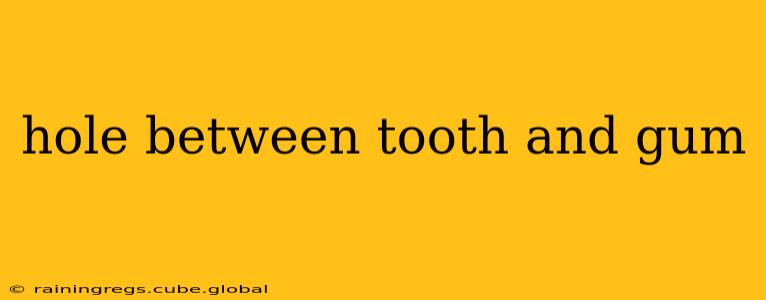A hole between your tooth and gum, often called a gum recession, is a common dental problem that can lead to serious oral health issues if left untreated. This condition exposes the root of your tooth, making it vulnerable to decay, sensitivity, and even tooth loss. Understanding the causes, symptoms, and treatment options is crucial for maintaining optimal oral health.
What Causes a Hole Between Your Tooth and Gum?
Several factors can contribute to gum recession, creating that bothersome hole between your tooth and gum line. These include:
- Aggressive brushing: Brushing too hard or using a hard-bristled toothbrush can damage the gum tissue over time, leading to recession.
- Gum disease (periodontitis): This bacterial infection inflames the gums, destroying the supporting structures of the teeth and causing them to loosen and recede.
- Genetics: Some individuals are genetically predisposed to gum recession, even with meticulous oral hygiene.
- Grinding or clenching teeth (bruxism): This habit puts excessive pressure on the teeth and gums, contributing to recession.
- Misaligned teeth: Crooked or crowded teeth can make it difficult to clean effectively, increasing the risk of gum disease and recession.
- Smoking: Smoking significantly increases the risk of gum disease and its associated complications, including gum recession.
- Hormonal changes: Fluctuations in hormone levels, particularly during pregnancy or menopause, can make the gums more susceptible to inflammation and recession.
- Piercings: Oral piercings, especially those near the gum line, can irritate the gums and contribute to recession.
What are the Symptoms of Gum Recession?
Recognizing the symptoms of gum recession early is crucial for timely intervention. Common signs include:
- Noticeable gaps between teeth and gums: This is the most obvious sign, a visible hole or space.
- Sensitive teeth: Exposed tooth roots are highly sensitive to temperature changes, sweet foods, and acidic drinks.
- Longer-appearing teeth: As the gums recede, the teeth appear longer than before.
- Loose teeth: In advanced cases, gum recession can weaken the tooth's support, leading to tooth looseness.
- Bleeding gums: While not always present, bleeding gums can indicate underlying gum disease.
How is a Hole Between Tooth and Gum Treated?
Treatment for gum recession depends on the severity of the condition and its underlying cause. Options include:
- Improved oral hygiene: Proper brushing and flossing techniques are essential to prevent further recession and manage existing gum disease.
- Scaling and root planing: This procedure removes plaque and tartar from the teeth and roots, helping to control gum disease.
- Gum grafting: This surgical procedure involves taking tissue from another area of the mouth (often the palate) and grafting it onto the receded area to cover the exposed roots. Different types of gum grafts exist, and your dentist will recommend the most suitable one based on your individual needs.
- Guided tissue regeneration (GTR): This advanced technique uses a membrane to guide tissue growth and help regenerate lost gum tissue.
- Enamel Matrix Derivative (EMD): This is a protein-based material used to stimulate natural tissue repair and regeneration.
How Can I Prevent Gum Recession?
Preventing gum recession involves adopting proactive oral hygiene habits and addressing any underlying conditions:
- Gentle brushing: Use a soft-bristled toothbrush and brush gently with short, back-and-forth strokes.
- Regular flossing: Flossing helps remove plaque and food particles from between the teeth and under the gum line.
- Regular dental checkups: Regular visits to your dentist allow for early detection and treatment of gum disease.
- Treating bruxism: If you grind or clench your teeth, your dentist may recommend a mouthguard to protect your teeth and gums.
- Quit smoking: Smoking significantly increases the risk of gum disease and other oral health problems.
What are the Long-Term Effects of Untreated Gum Recession?
Ignoring gum recession can lead to severe consequences:
- Tooth sensitivity: Increased sensitivity to hot, cold, sweet, and acidic foods and drinks.
- Tooth decay: Exposed tooth roots are more vulnerable to decay.
- Tooth loss: Severe gum recession can weaken the teeth, leading to their eventual loss.
- Bone loss: Gum recession is often accompanied by bone loss, further compromising the stability of the teeth.
Does Gum Recession Always Require Treatment?
Not all gum recession requires immediate treatment. Minor recession that doesn't cause any symptoms may not require intervention. However, regular monitoring by your dentist is essential to detect any changes or potential problems.
Can Gum Recession be Reversed?
While complete reversal of gum recession isn't always possible, treatments can help stop further recession, improve gum health, and restore the gum line to some extent. The success of treatment depends on the severity of the recession and the individual's response to therapy.
This information is for general knowledge and does not constitute medical advice. Always consult with a qualified dentist or periodontist for diagnosis and treatment of gum recession or any oral health concern. Early detection and intervention are key to maintaining a healthy smile.
